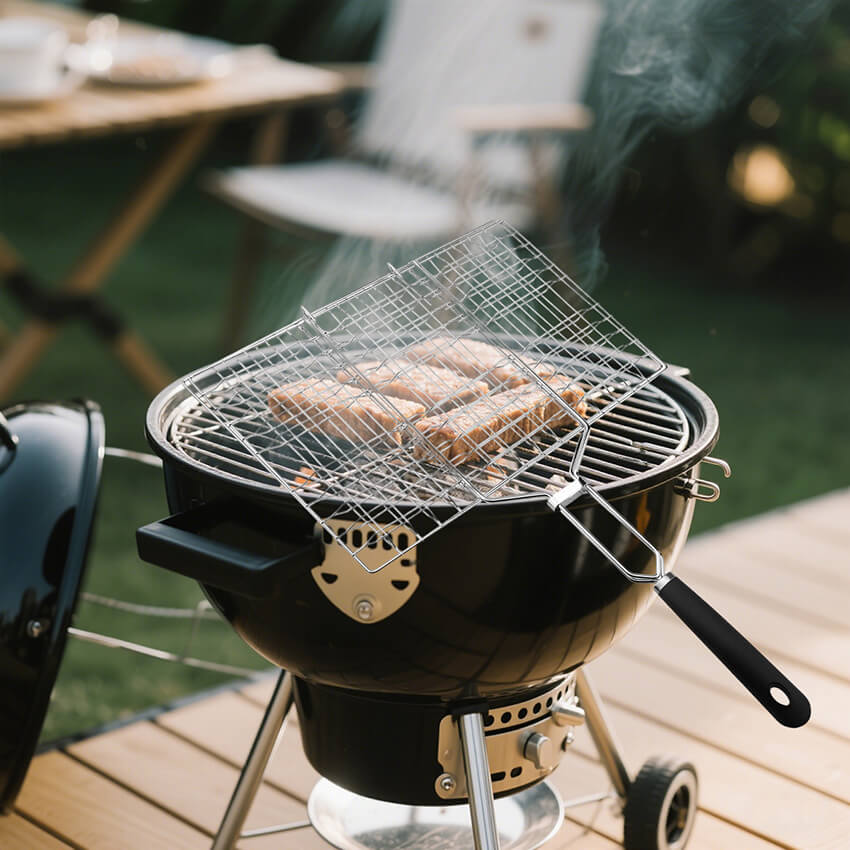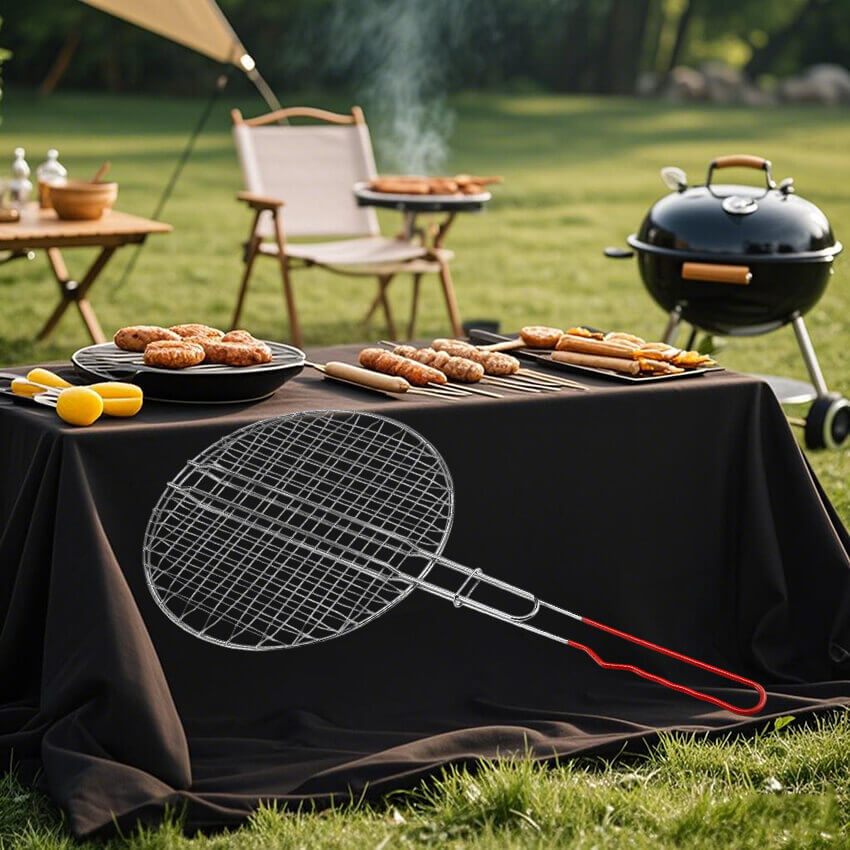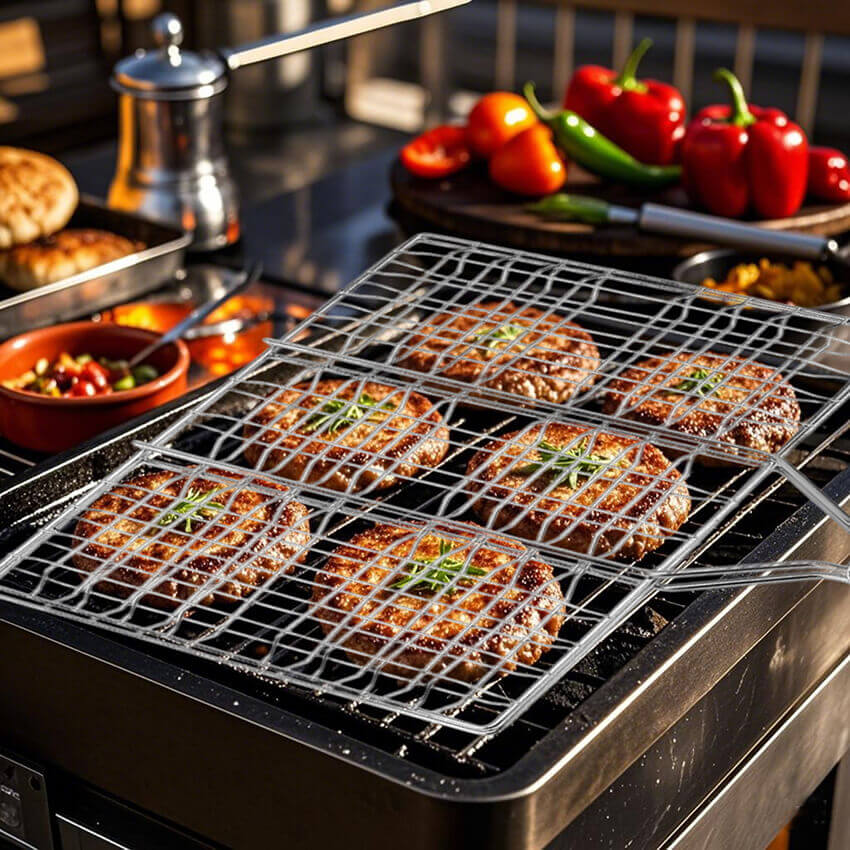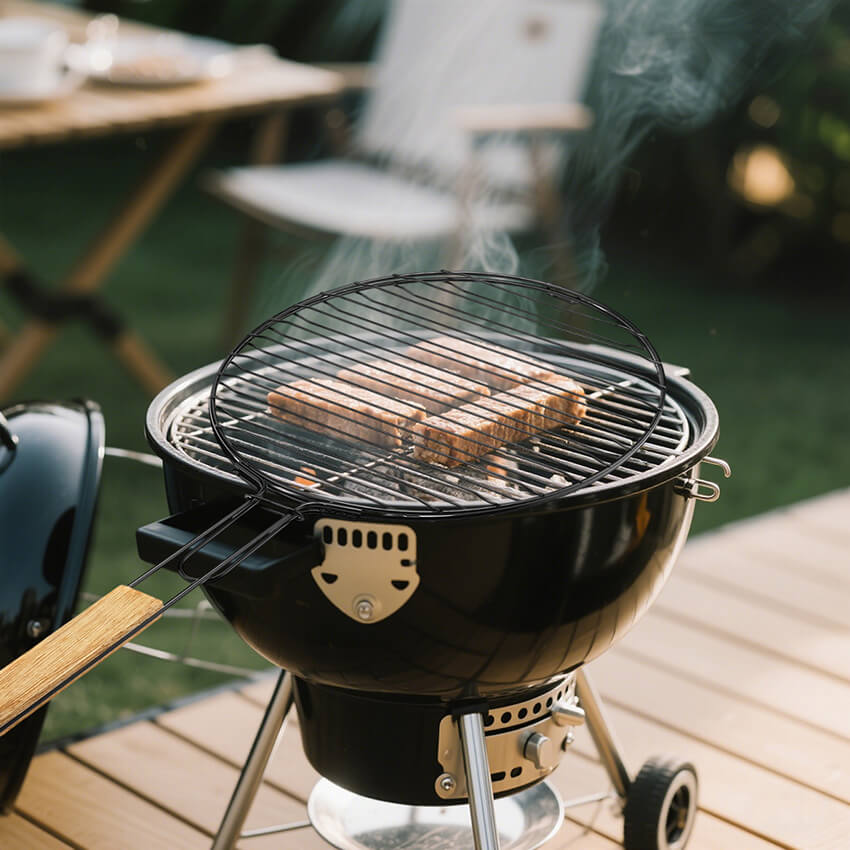![]() Windy.
Windy.
 WeChat
WeChat
 WhatsApp
WhatsApp
Click:274 seen
The circular baking sheet and the square baking sheet differ in the following aspects:
Shape and Appearance
Circular grill net: Circular in shape, with smooth and rounded lines, giving a natural and harmonious aesthetic. In outdoor barbecue scenarios, it can better blend with the natural environment and add a rustic charm.
Square grill net: Square or rectangular in shape, with clear edges. It gives a simple and neat feeling, making it more suitable for pairing with some minimalist and regular barbecue equipment. Kitchenware Square grill net
Compatibility
Circular grill net: Generally suitable for circular or arc-shaped barbecue grills, it can better fit the shape of the grill, making the heat distribution more uniform and improving the cooking efficiency. Some specially designed circular grills, when paired with circular grill nets, can achieve the best cooking results.
Square grill net: Due to its structural characteristics, it is suitable for various shapes of barbecue grills, including square, rectangular, and some irregular-shaped ones. It has stronger versatility and adaptability, suitable for both home and commercial barbecues, and can be easily adapted.
Space Utilization
Circular grill net: Due to its circular shape, the edge space of the grill is relatively difficult to be fully utilized, especially for some neatly shaped foods, such as square bread slices, block-shaped tofu, etc. This may result in unstable placement or wasted space.
Square grill net: The square design makes it more space-efficient. It can fully utilize every corner of the grill, allowing for more regular placement of various-shaped foods, resulting in more even heating and better cooking effects. Especially for foods that need to be closely arranged for cooking, such as chicken wings, meat slices, etc., square grill nets can better meet the requirements.

Heat Distribution
Circular grill net: Theoretically, the heat distribution of the circular grill net is more uniform. During the cooking process, the food is heated more evenly, and there is less risk of local overheating or burning. The cooked food has a better taste.
Square grill net: Although the square grill net can also heat the food, there may be a concentration of heat at the edges, causing the edges of the food to easily burn. During the cooking process, more attention needs to be paid to flipping and adjusting the position of the food.
Cleaning Difficulty
Circular grill net: The circular shape of the grill net has no sharp edges, and the surface is relatively smooth. When cleaning, it is less likely to have food debris remaining. However, due to its circular shape, more turning and wiping may be required to ensure that the entire grill surface is cleaned.

Circular and square grill nets have different effects on barbecue food due to their shapes and structures. The specific differences are as follows:
1. Food Placement and Adaptability
Circular grill net
Suitable food types: Suitable for placing circular, arc-shaped or irregular-shaped foods, such as whole chicken legs, corn, sausages, etc. They can be evenly arranged along the edge of the grill net to avoid shape mismatch and rolling or unstable placement.
Limitations: It has poor adaptability for square, long-shaped foods (such as toast slices, steaks). The edge area is prone to gaps, which may cause food to fall or be placed unevenly, affecting the cooking efficiency.
Square grill net
Suitable food types: More suitable for square, long-shaped or cut-shaped foods, such as chicken wings, tofu blocks, vegetable skewers, etc. It can use the right-angle edges for regular arrangement, especially for foods that need precise placement (such as batch cooking in commercial barbecues), maximizing the use of the grill net area.
Advantages: The edges can fix long-shaped foods (such as asparagus, chives) to avoid rolling, suitable for scenarios that require precise control of placement (such as batch cooking in commercial barbecues).
2. Heat Distribution and Cooking Uniformity
Circular grill net
Heat characteristics: The circular structure theoretically has more uniform heat conduction, with a smaller temperature difference between the center and the edges. It is suitable for cooking foods that are sensitive to temperature (such as fish, shrimp), and is less likely to cause local burning or under-cooking in the middle.
Effect: The food surface is heated evenly, and the color is more consistent. It is especially suitable for ingredients that prefer a crispy exterior and tender interior (such as grilled chicken wings), and the cooking effect can be guaranteed without frequent flipping.
Square cooking rack
Heat characteristics: Due to the structure, the edges may have concentrated heat (especially when using charcoal for grilling), causing the edges of the food to easily get burnt. Frequent flipping is necessary to adjust the position; the middle area has relatively balanced heat and is suitable for cooking ingredients that can withstand high temperatures (such as grilled meat, potato chunks).
Precautions: When cooking thin slices of food (such as bacon, vegetables), pay attention to the heat at the edges to avoid burning and affecting the taste.

3. Food Contact Area and Taste
Circular cooking rack
Contact area: The lines of the circular grid have a larger arc, and the contact points between the food and the cooking rack are more dispersed, suitable for ingredients that need to retain moisture (such as fish, soft fruits), reducing water loss due to local high temperature, and resulting in a fresher and more tender taste.
Suitable scenarios: In family barbecues that aim for healthy cooking (less oil, preserving the original flavor of the ingredients), or for cooking foods that are prone to sticking to the rack (such as eggplant, green peppers), an arc-shaped grid can reduce sticking.
Square cooking rack
Contact area: The right-angle edges of the square grid are closer to the food, forming clear grill marks (such as the grid pattern of steak), suitable for ingredients that prefer a crispy flavor or visual effect. Under high heat, it can quickly lock in the meat juices, making the outer skin more crispy.
Typical case: Barbecue restaurants often use square cooking racks when grilling steak and pork chops, creating a crispy crust under high heat while maintaining juicy interiors.
4. Flipping Actions and Operational Convenience
Circular cooking rack
Operation characteristics: Due to the symmetrical shape, flipping the food does not require deliberate direction adjustment, making it suitable for beginners; when cooking round-shaped food (such as corn, bread), it can be rolled over to flip, reducing food damage.
Limitations: If the cooking rack diameter is large, the food at the edges needs to be adjusted with hands, which may cause inconvenience (especially when the outdoor barbecue stand is at a high height).
Square cooking rack
Operation characteristics: The edges are clear, allowing for flipping by dividing areas (such as left upper and right lower areas), suitable for batch cooking where classification management is required (such as cooking meat and vegetables simultaneously); a long strip-shaped cooking rack can be flipped horizontally with a clamp, resulting in higher efficiency.
Advantages: In commercial barbecues, square cooking racks are more convenient for standardized operations, such as flipping by rows, controlling cooking time, and improving service efficiency.

Summary: How to choose the cooking rack based on the food?
Select circular cooking rack: Suitable for cooking "irregular shapes, requiring uniform heating, and retaining moisture" food (such as fish, whole chicken, corn), or scenarios in family casual barbecues that aim for simple operation and tender taste.
Select square cooking rack: Suitable for cooking "regular shapes, requiring a crispy flavor, and batch management" food (such as steak, chicken wings, vegetable skewers), or scenarios in commercial barbecues, outdoor gatherings where efficiency and visual effect are required.
